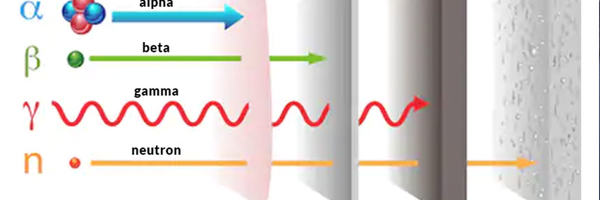Finding Better Materials To Protect Future Generations From the Effects of Radioactivity
Grade 6
Presentation
Hypothesis
If the barrier is effective then the readout on the Geiger counter will be lower than if the barrier is not effective. The readout on the Geiger counter will be lower because there will be fewer ion pairs created per minute in the chamber of the Geiger counter. There will be fewer ion pairs created per minute because less radiation will be entering the chamber since the barrier will be blocking or absorbing the radiation. We also predict that the emergency blanket will block the most radiation. We think this because it keeps heat in. And since heat is sometimes a characteristic of radiation, the emergency blanket should be able to block radiation well.
Research
What is Radioactivity?
Radiation is energy that comes from a source and travels through space at the speed of light. This energy has an electric field and a magnetic field associated with it, and has wave-like properties. You could also call radiation “electromagnetic waves”, (Center for Disease Control and Prevention, 2022). This explains what radiation is.
Ionizing radiation is considerably more energetic. When ionizing radiation passes through material such as air, water, or living tissue, it deposits enough energy to produce ions by breaking molecular bonds and displace (or remove) electrons from atoms or molecules, (United States Nuclear Regulatory Commission, 2021). This quote shows that when testing radiation, you should use ionizing radiation. This will give you more penetrating radiation. This also shows why ionizing radiation is more radioactive than non-ionizing radiation.
Radiation is energy that comes from a source and travels through space and may be able to penetrate various materials. (Division of Public Health, 2023) This quote explains in a simple way what radiation is.
Space radiation is comprised of atoms in which electrons have been stripped away as the atom accelerated in interstellar space to speeds approaching the speed of light – eventually, only the nucleus of the atom remains, (National Aeronautics and Space Administration, 2017). This explains how cosmic radiation is produced.
Everything in nature wants to be more stable, and so is it too with an atom. When there is an imbalance of protons and neutrons in a nucleus, it disintegrates and gives out radiation by a process called radioactive decay. The atom can disintegrate in various ways, such as alpha, beta and gamma decay, (“Types of Radioactive Decay Study Guide”, 2022). This explains how radiation is produced and what an atom can disintegrate into when it starts to enter the process called radioactive decay.
What Are Alpha, Gamma, and Beta Rays?
The radiation one typically encounters is one of four types: alpha radiation, beta radiation, gamma radiation, and x radiation. Neutron radiation is also encountered in nuclear power plants and high-altitude flight and is emitted from some industrial radioactive sources, (Alaska Department of Health, 2020). This is important because it explains the different types of radiation that scientists have discovered. It also tells you where you encounter neutron radiation.
Beta-decay is of two types: 𝛃- and 𝛃.
The easiest way to remember the types is that 𝛃- gives out a negatively charged particle and 𝛃 gives a positively charged one, (“Types of Radioactive Decay Study Guide”, 2022). This explains the two types of beta decay and why they are different.
What Are Sources of Radioactivity?
Space radiation is made up of three kinds of radiation: particles trapped in the Earth’s magnetic field; particles shot into space during solar flares (solar particle events); and galactic cosmic rays, which are high-energy protons and heavy ions from outside our solar system. All of these kinds of space radiation represent ionizing radiation, (National Aeronautics and Space Administration, 2017). This tells us what some sources of radiation in space are and what causes them.
People are constantly exposed to small amounts of ionizing radiation from the environment as they carry out their normal daily activities; this is known as background radiation. We are also exposed through some medical treatments and through activities involving radioactive material, (“Types and sources of radiation,” 2023). This explains what radiation we are always exposed to. It also says that this radiation is called background radiation.
What Are Sources of Natural, Safe Radioactivity That Are Commonly Available?
Like bananas, Brazil nuts contain potassium, but they also contain a small amount of radium that is taken up from the soil in which they are grown, (“Natural Radioactivity in Food | US EPA”, 2023). This quote explains why Brazil nuts are generally more radioactive than bananas by telling us how they get radium from the soil they are grown in.
Interestingly, there is a "background" of natural radiation everywhere in our environment. It comes from space (i.e., cosmic rays) and from naturally occurring radioactive materials contained in the earth and in living things, (Alaska Department of Health, 2023). This explains what background radiation is caused by and where it is in the world. This is important because it helped us learn about background radiation and how it might affect our results.
Table 1: Potassium-40 content in food
Food Becquerel (Bq) per 500 grams
Red meat 56
Carrot 63
White potato 63
Banana 65
Lima bean 86
Brazil nut 103, (“Types and sources of radiation,” 2023). This shows how many Becquerels you can get from 500 grams of different foods. It is important because it helped us visualize what source of radiation we should use.
How Do I Measure Radioactivity?
A Geiger counter has two main parts—a sealed tube, or chamber, filled with gas, and an information display. Radiation enters the tube and when it collides with the gas, it pushes an electron away from the gas atom and creates an ion pair. A wire in the middle of the tube attracts electrons, creating other ion pairs and sending a current through the wire. The current goes to the information display and moves a needle across a scale or makes a number display on a screen. These devices usually provide "counts per minute," or the number of ion pairs created every 60 seconds. If the loudspeaker is on, it clicks every time an ion pair is created. The number of clicks indicates how much radiation is entering the Geiger counter chamber, (United States Nuclear Regulatory Commission, 2020). This explains how a Geiger counter works and a bit of how to use a Geiger counter.
What is The Best Source of Radioactivity to Use for This Experiment?
Brazil nuts contain some natural radionuclides at higher levels than other foods, (“Natural radioactivity in food - Natural radioactivity in food”, 2023). This explains why Brazil nuts are a stronger radiation source than other foods.
How Can Radioactivity Be Absorbed or Blocked?
Barriers of lead, concrete, or water provide protection from penetrating gamma rays and X-rays. This is why certain radioactive materials are stored under water or in concrete or lead-lined rooms, (“Protecting Yourself from Radiation | US EPA” 2023). This is important because it explains what materials block radiation well and how these materials are used to store radioactive items.
For space radiation shielding, low Z materials with a low density of neutrons and the highest density of electrons per atom are preferred.
Hydrogen is the best material for shielding against space radiation as it has the highest density of electrons per nucleon and no neutrons, (STEMRAD, 2021). This quote is important because
Particular types of glass are crucial for applications in medicine and the nuclear industry as they offer exceptional shielding against various types of radiation, (“Radiation Shielding and the Utilization of Glass,” 2021). This explains how there are certain types of glass that can be used for shielding yourself against radiation.
How Can Sources of Radiation Like Brazil Nuts Be Harmful to Your Body?
Eating too many Brazil nuts can lead to toxic levels of selenium in the body (selenosis) and cause symptoms such as bad breath, diarrhea, nausea, skin rashes/lesions, nerve pain and fatigue. In rare cases, very high levels can cause kidney failure, cardiac arrest and even death, (The Science of Health, 2023). This is important because it shows you the consequences of consuming too much of some elements.
Variables
Manipulated: Material used as a barrier (materials are aluminum, titainium, concrete, water and plastic). Responding: Amount of radiation. Control: Distance between source and geiger counter, source of radiation, room test takes place in, mass of sourceof radiation, temperature of room, surface area of barrier, thickness of barrier.
Procedure
Procedure for With Barriers
- Set up a testing table in a room with no other sources of radiation.
- Turn on the Geiger counter, and in the settings set the unit to Counts Per Minute (CPM), and turn off the Geiger counter.
- Set the Geiger counter on the testing table. Turn the Geiger counter on and start a 1-minute timer at the same time. Once the timer goes off check the amount of radiation the Geiger counter has detected and record it for later use, this will be your background radiation. Turn the Geiger counter off.
- Place the Geiger counter into the glass jar.
- Peel the bananas, and place the source of radiation on the ceramic plate (whole Bananas), place the plate with the peeled bananas 1 foot (0.3048 meters) away from the Geiger counter on the testing table.
- Turn on the Geiger counter and start a 1-minute timer. Leave the Geiger counter in the jar for 1 minute and record the amount of radiation recorded by the Geiger counter at the end of 1 minute. This number will be compared to the amount of radiation that is detected with the barrier.
- Turn off the Geiger counter and then turn it back on and start a 2-minute timer at the same time. Immediately place the barrier being tested against the opening in the jar so that the source of radiation does not have any other way to get to the Geiger counter.
- Record the number displayed on the Geiger counter.
- Repeat these steps 10 times for each different barrier.
Brazil nuts or Bananas Procedures
Brazil Nuts Whole Procedure:
- Set up the work area.
- Get out Brazil nuts
- Turn on the Geiger counter in the work area and wait for 1 minute as the Geiger counter measures the background radiation. Record the amount of background radiation shown on the screen.
- Place the Brazil nuts in one of the water bottles
- Set the water bottle on the table and place the Geiger counter in front of the opening in the water bottle.
- Set a timer for 2 minutes and wait.
- Record the number on the screen of the Geiger counter and take away the number recorded as background radiation from earlier.
Brazil Nuts Ground Procedure:
- Set up the work area.
- Get out the Brazil Nuts.
- Turn on the Geiger counter in the work area and wait for 1 minute as the Geiger counter measures the background radiation. Record the amount of background radiation shown on the screen.
- Grind the 3 Brazil nuts in the food processor.
- Pour the ground Brazil nuts into the water bottle used for the whole Brazil nuts.
- Set the water bottle on the table and place the Geiger counter in front of the opening in the water bottle.
- Set a timer for 2 minutes and wait.
- Record the number on the screen of the Geiger counter and take away the number recorded as background radiation from earlier.
Banana Whole Procedure:
- Set up the work area.
- Get out the bananas and peel them. Once peeled place on the plate
- Turn on the Geiger counter in the work area and wait for 1 minute as the Geiger counter measures the background radiation. Record the amount of background radiation shown on the screen.
- Place the plate on the table and place the Geiger counter in front of it.
- Set a timer for 2 minutes and wait.
- Record the number on the screen of the Geiger counter and take away the number recorded as background radiation from earlier.
Banana Smushed Procedure:
- Set up the work area.
- Place bananas in the bowl and mash to a pulp.
- Place Banana pulp in the water bottle that you have not yet used.
- Turn on the Geiger counter in the work area and wait for 1 minute as the Geiger counter measures the background radiation. Record the amount of background radiation shown on the screen.
- Place the water bottle with the bananas on the table and place the Geiger counter in front of it.
- Set a timer for 2 minutes and wait.
- Record the number on the screen of the Geiger counter and take away the number recorded as background radiation from earlier.
Observations
Background Radiation Test Control Test
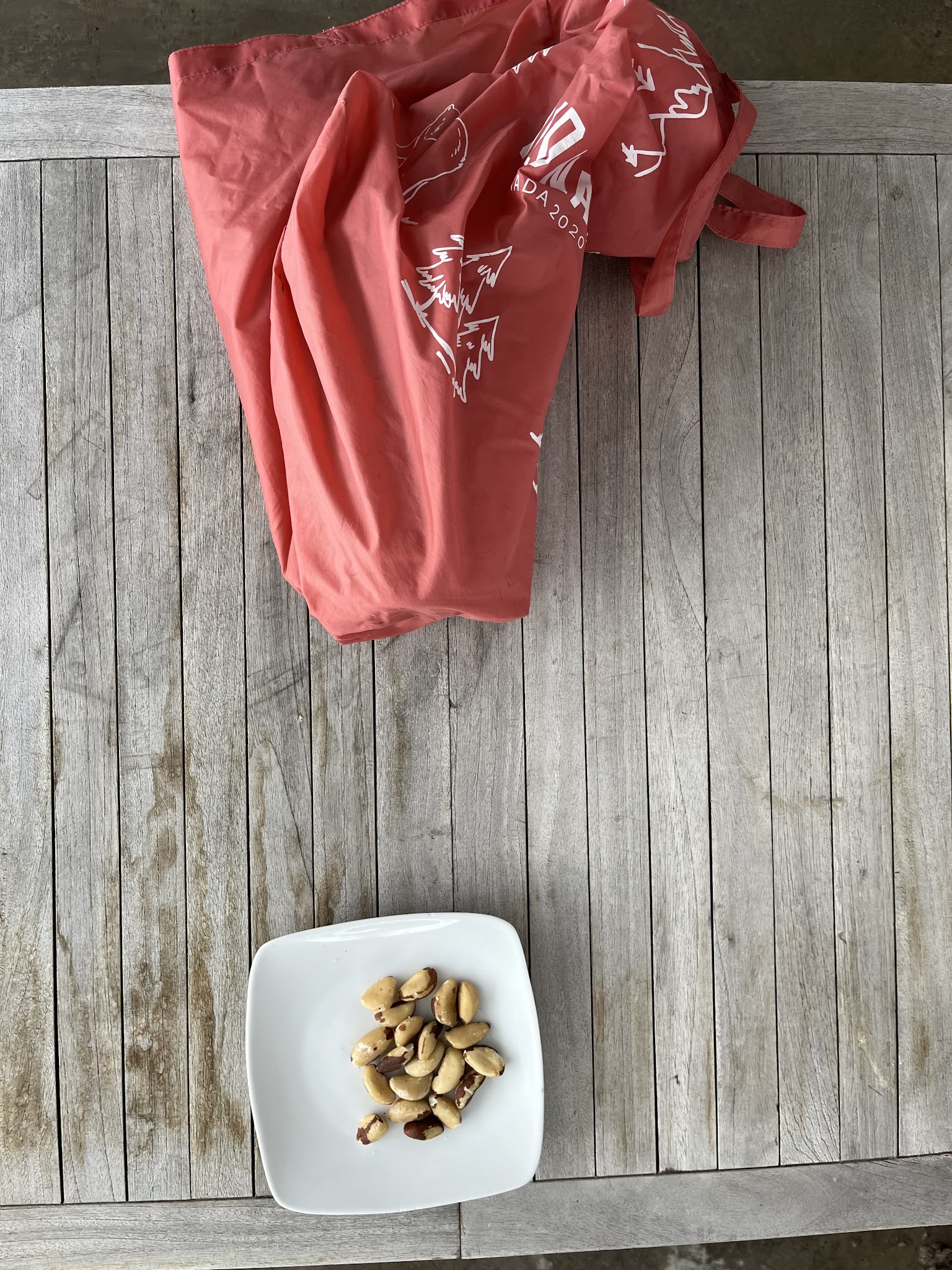
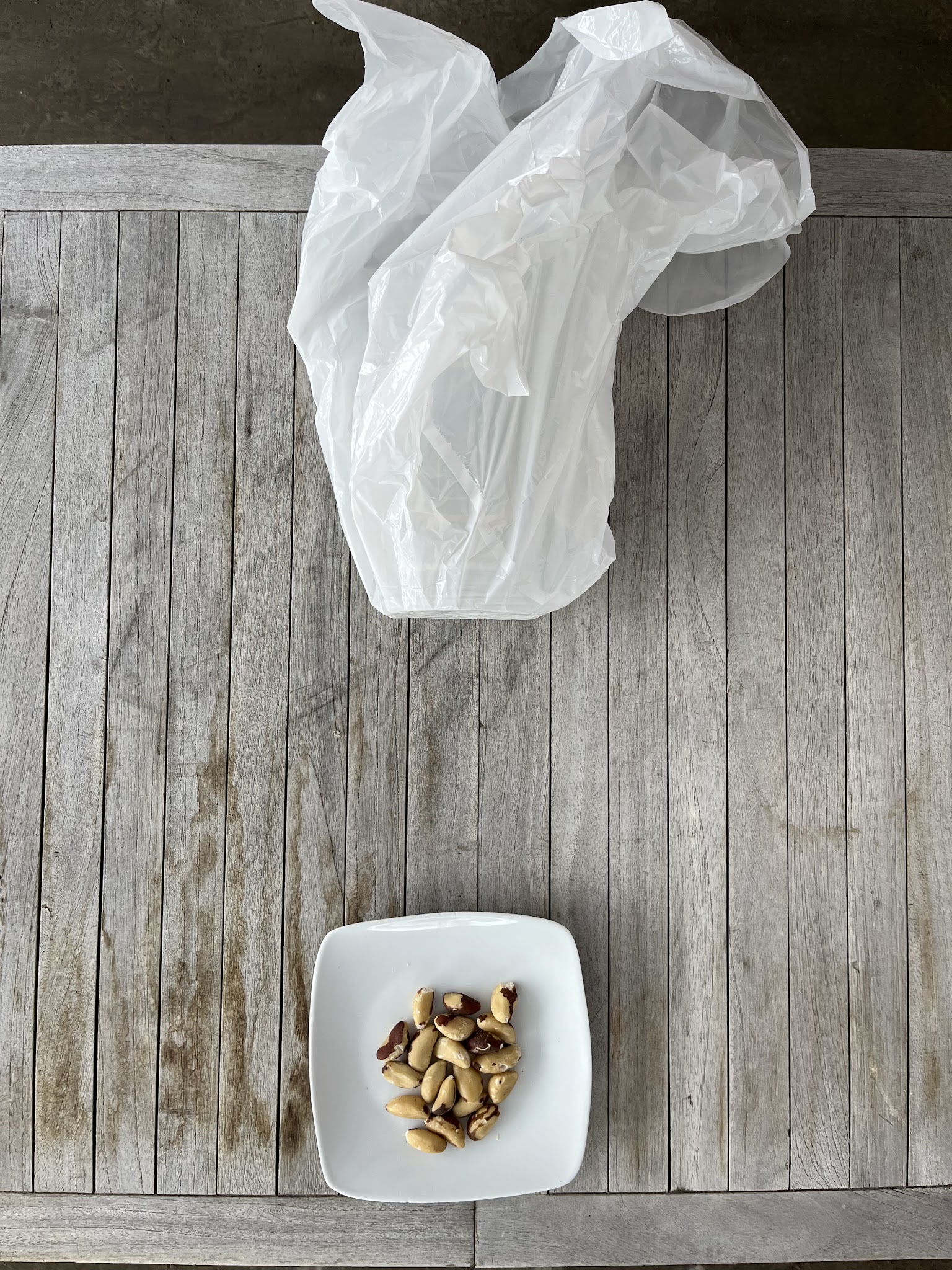 Material #1 Nylon Material #2 Flexible Plastic
Material #1 Nylon Material #2 Flexible Plastic
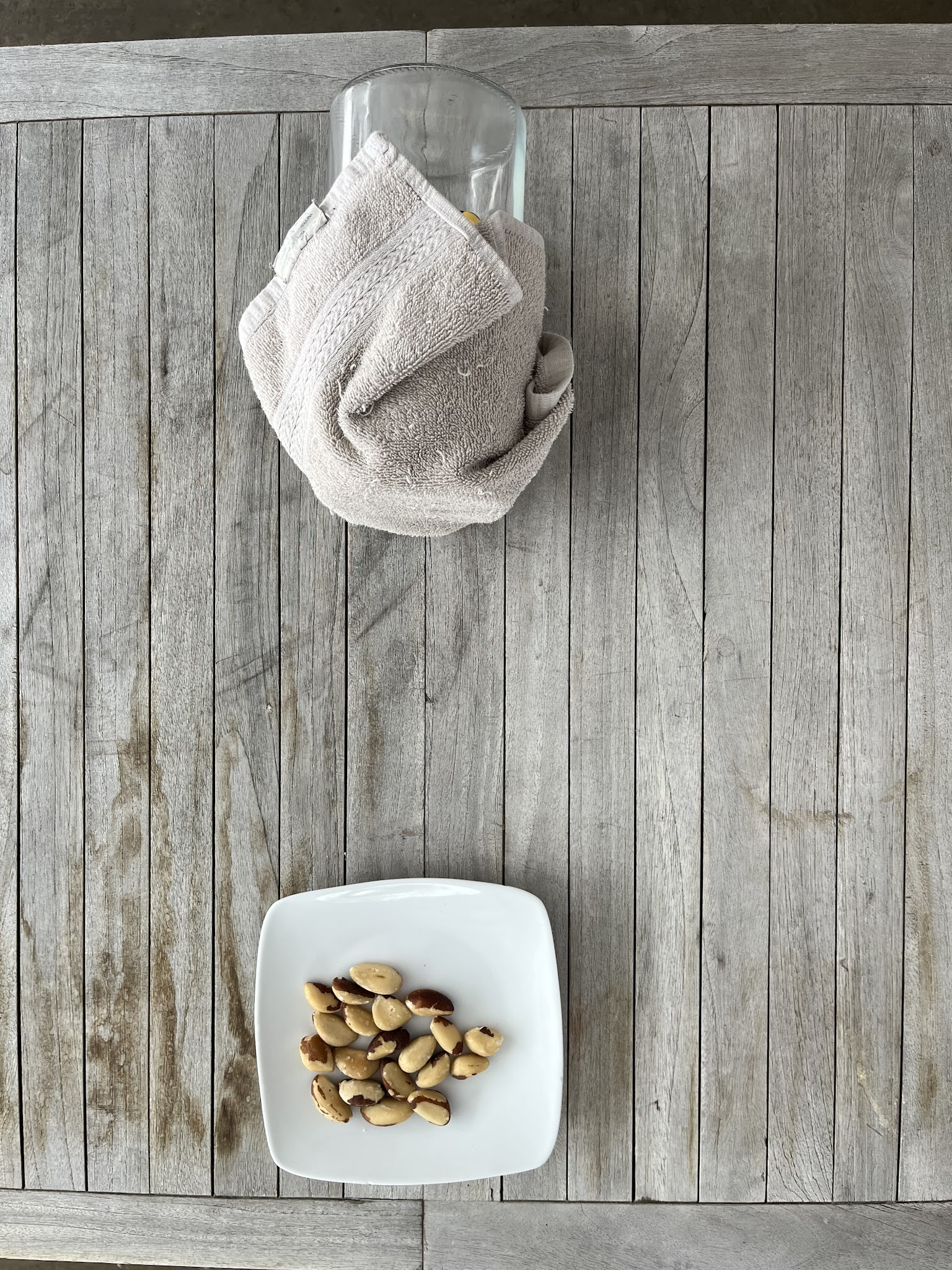
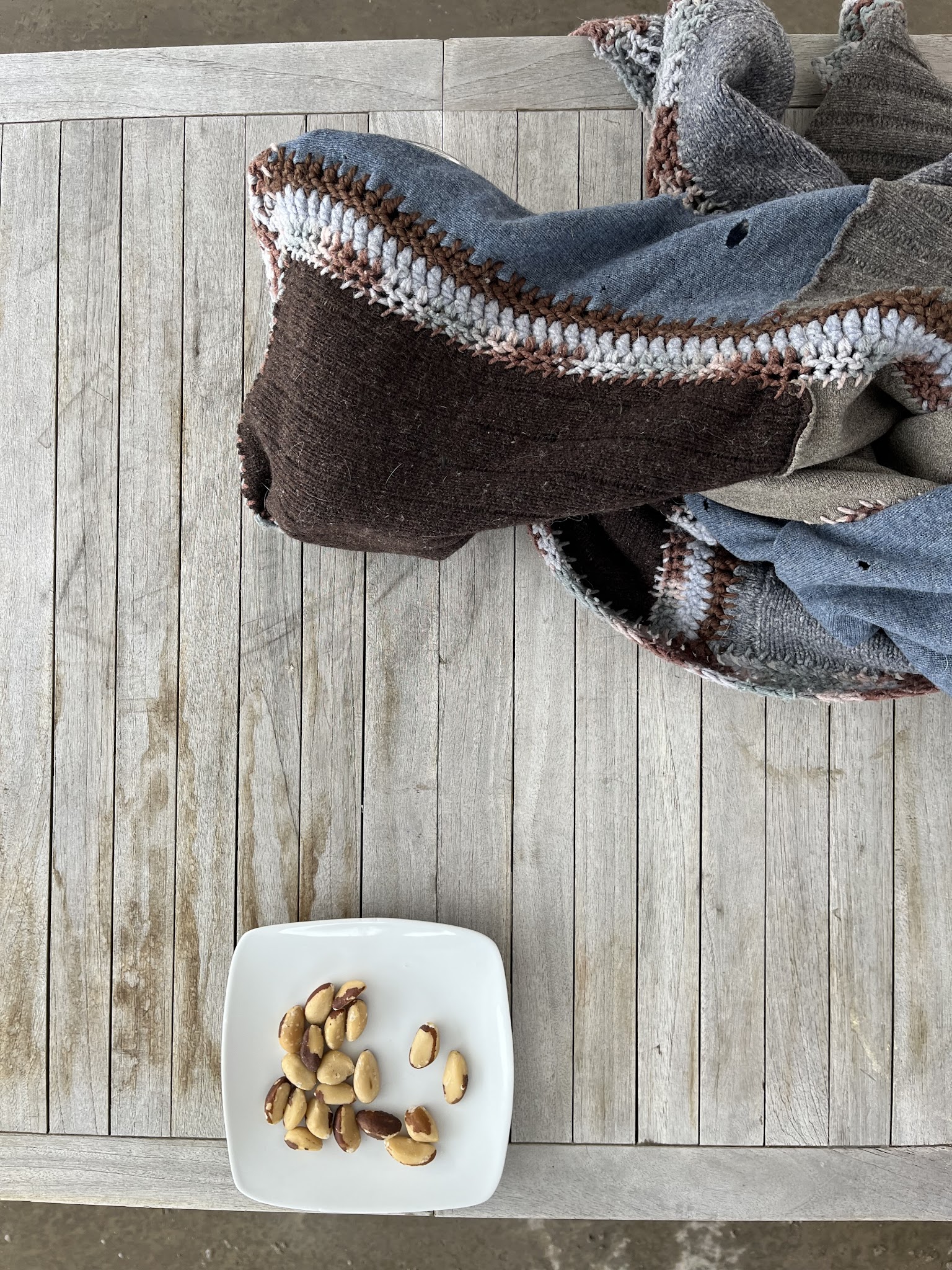
Material #3 Cotton Material #4 Wool
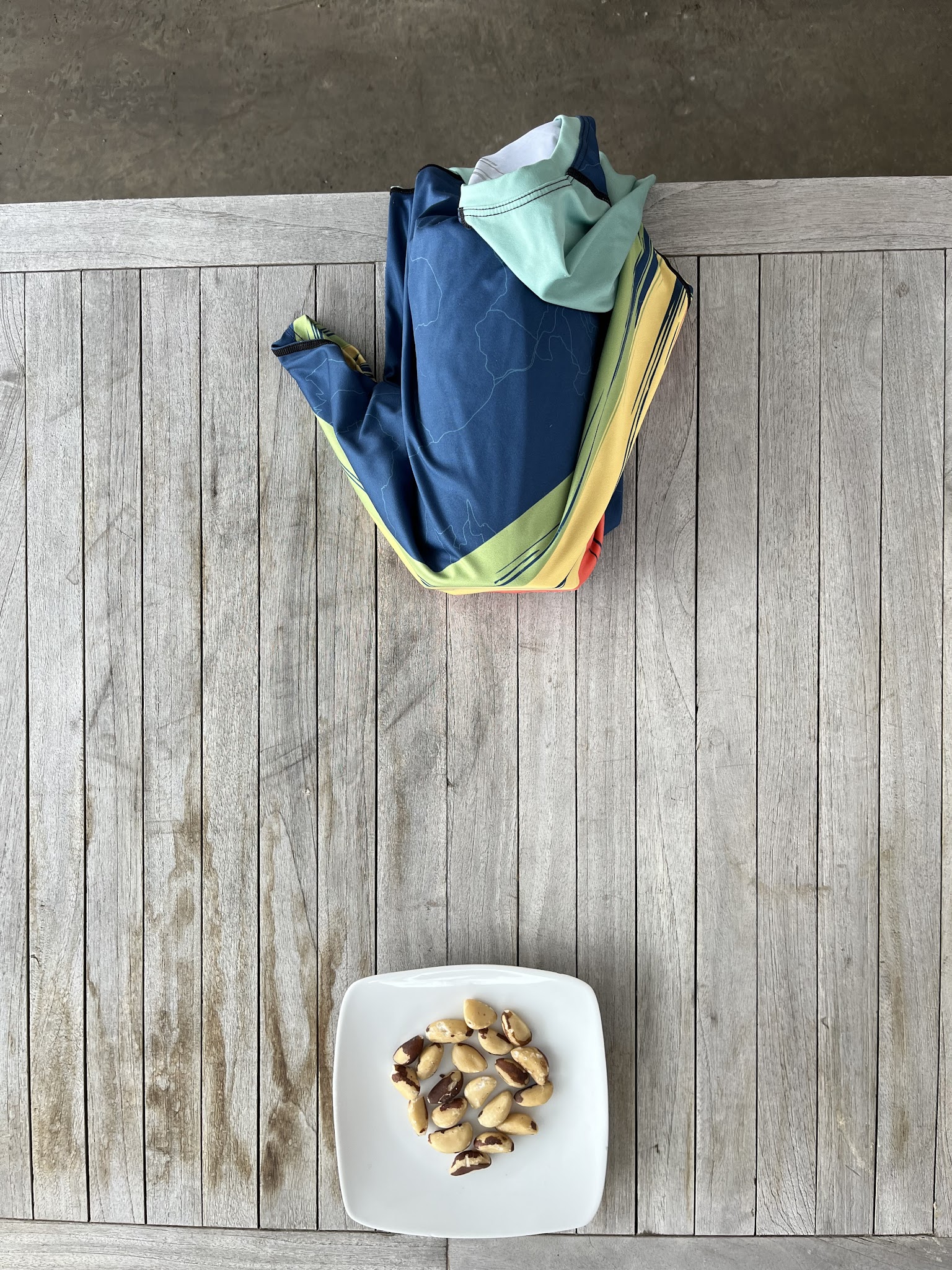
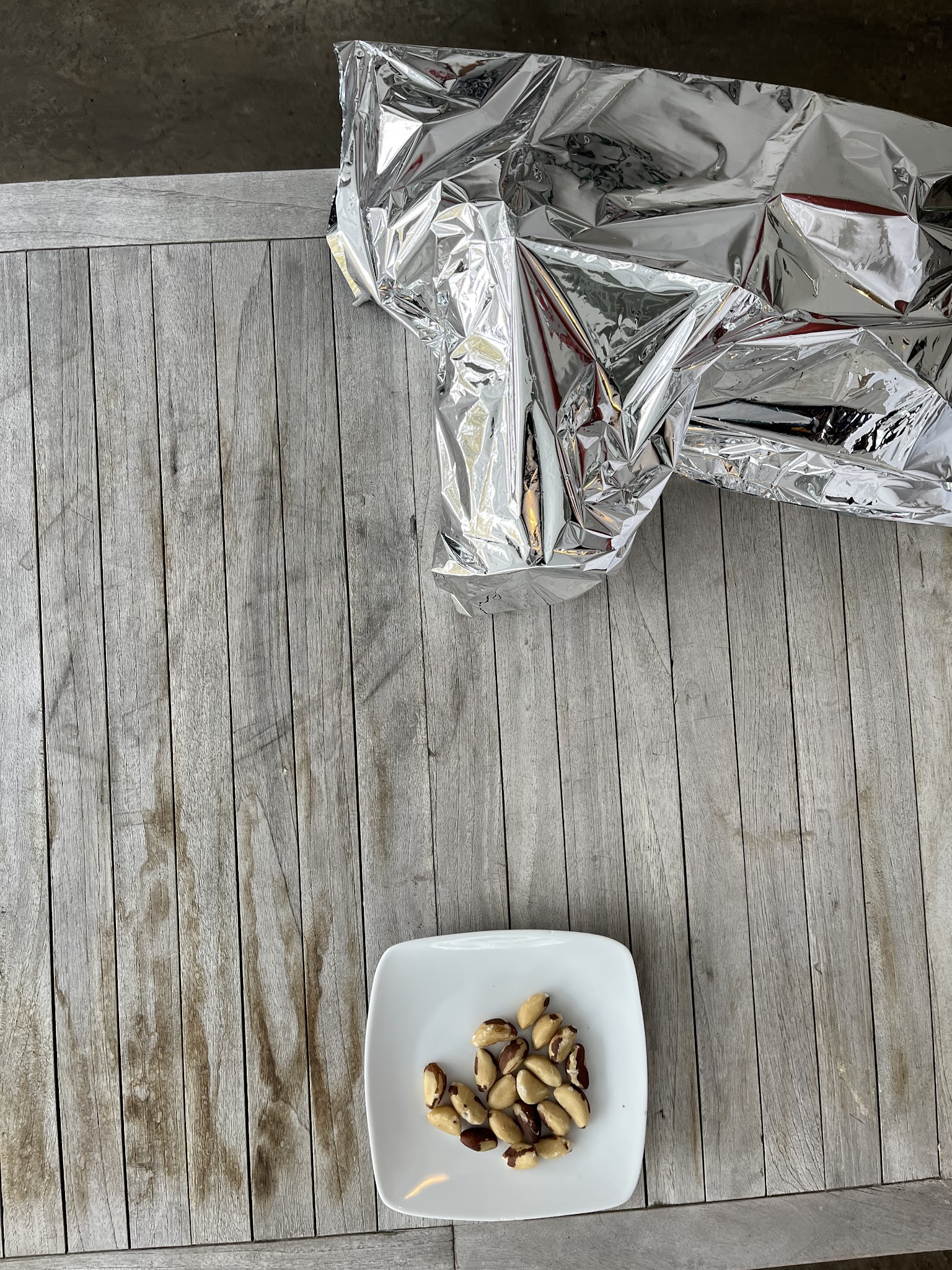
Material #5 Polyester Material #6 Illinois industrial tool 35585 emergency shelter with cord
Material #7 Insulated Material #8 Airport X-ray Film Camping Ground Cover Protector
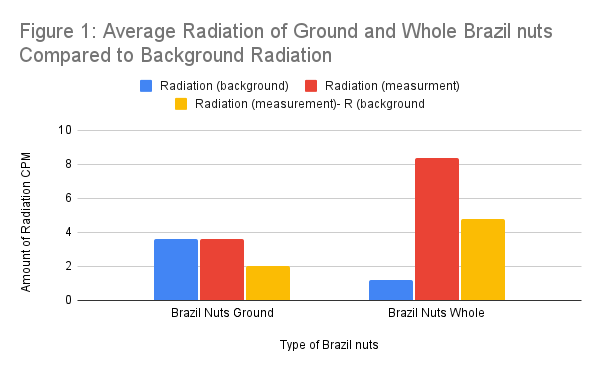
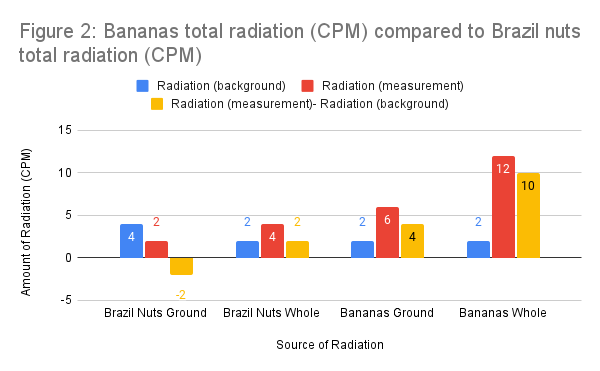
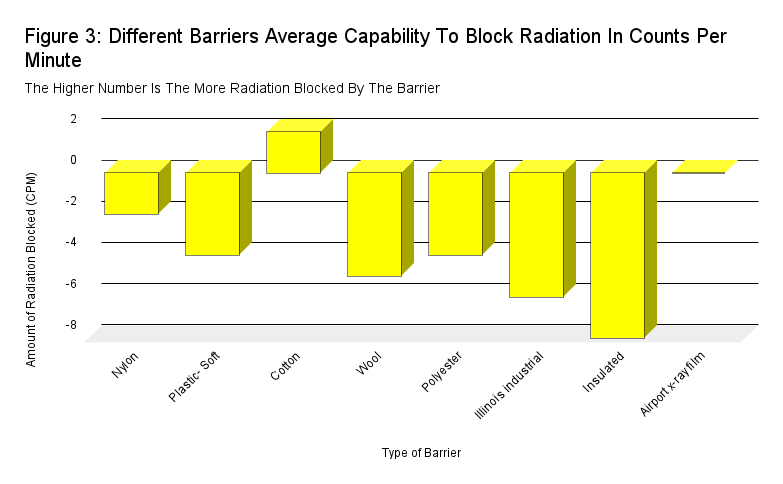
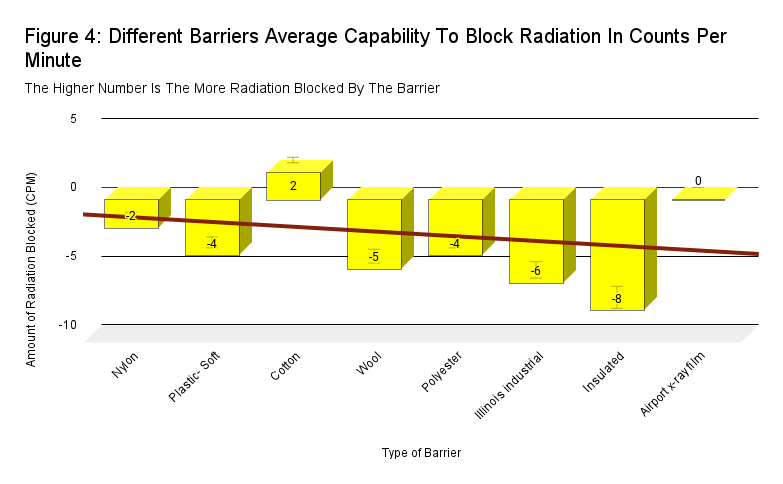
I noticed that in our control test, if the amount of radiation detected by the Geiger counter was high then our results at the end of that trial made more sense than if the amount of radiation detected by the Geiger counter was lower.
Analysis
In this experiment, we studied how well different types of barriers blocked radiation. We tested the independent variable, the barrier, against radiation by measuring how much radiation got through the barrier. In Figure 3, we found that cotton blocked the most radiation with an average of 2. When looking at Figure 3, we saw that all the results of cotton were clustered near 0. We think this is partially because of the weave in the cloth we were using. Our next best result was our airport X-ray film protector (a bag made out of lead and plastic). Figure 3 shows our airport X-ray film protector with an average of 0. Compared to barriers such as our insulated camping blanket which is at an average of -8 these results are very good. Figure 1 shows the average radiation of ground and Brazil nuts and whole Brazil nuts compared to the radiation taken away from the total radiation recorded by the Geiger counter. Figure 2 shows the total radiation of bananas whole and ground compared to the total radiation of Brazil nuts whole and ground. Figure 3 shows the capability of different barriers to block radiation. Figure 4 shows the capability of different barriers to block radiation with error bars and a trendline.
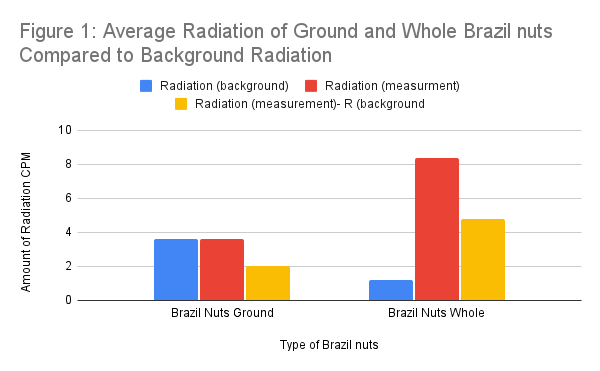

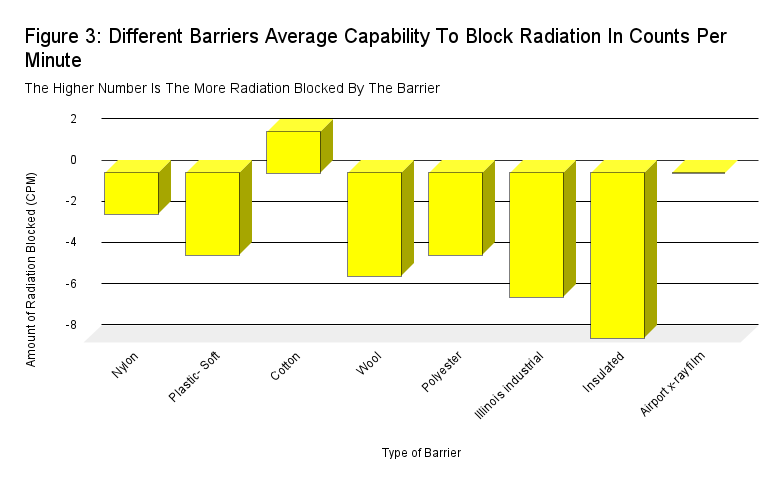

Conclusion
Based on our background research, we hypothesized that if the barrier is effective then the amount of radiation detected by the Geiger counter will be lower than if the barrier is not effective. The evidence found in our background research that supported our hypothesis that there will be fewer ion pairs created per minute because less radiation will be entering the chamber since the barrier currently in use will be blocking or absorbing the radiation produced by the Brazil nuts.
Our experiment showed that cotton was the best barrier we used since in Figure 3 the average number of counts that cotton blocked was 2, which compared to the other barriers is good considering that the other highest result was Airport X-Ray Film which had an average of 2 counts per minute blocked. When we created Figure 4 it had a trendline, on the trendline we noticed that the closer you got to the last barrier that we tested the less radiation blocked with the only exception as Airport X-ray film and cotton. Something else that is interesting is that the less radiation that the barrier blocked on average, the larger the error bars were even though we did the same amount of tests on every barrier.
We were surprised that the cotton got higher results than Airport X-ray film, which has
a thin layer of lead in it. Based on our background research, lead can block radiation very well which is why radioactive waste is sometimes stored in lead-lined rooms. Sometimes we got results that did not make sense such as when all of our barriers got lower results than they usually do in trial 4. We think that most of the results that do not make sense are because of background radiation changing when we are testing our barrier.
In conclusion, cotton has blocked the most radiation. When we were doing our tests with the barriers, the amount of radiation that the Geiger counter detected was almost always lower than our control test. It was only higher when the background radiation changed while we were measuring the barrier. Our hypothesis was correct, the more radiation that the barrier blocked or absorbed, the lower the amount of radiation that the Geiger counter detected.
Application
Nuclear power plants
There is a growing risk of nuclear meltdowns, “nearly three dozen nuclear power plants are inadequately protected against major flooding guaranteed to occur after an upstream dam failure – flooding that could easily lead to an accident or meltdown on the scale of the 2011 nuclear power disaster in Fukushima, Japan.” (Government Accountability Project, 2022) There is also risk due to natural disasters from a warming climate and war. Is there an inexpensive material that people in high-risk areas can carry to quickly throw on to protect them in an emergency?
The material should be inexpensive and accessible because “the benefits from hosting a nuclear power plant tend to go to whiter and wealthier communities, whereas the riskier activities like uranium mining and milling have been concentrated in poorer communities, less educated communities, and communities of color.” (Good Energy Collective, 2022)
Airplanes - radiation exposure, is there an article of clothing to minimize risk?
“You would be exposed to about 0.035 mSv (3.5 mrem) of cosmic radiation if you were to fly within the United States from the east coast to the west coast.” A business person who flew a 6-hour round trip from the east to the west coast of the U.S.A. (once every month) would receive 0.8352 mSv/year which is the equivalent of approximately 90 CPM extra over a year. This is not a very high level of radiation but can increase your risk of cancer if you do this for multiple years. Can we inform people that they should minimize their rate of flights a year or if that is not possible then they should wear closely woven cotton clothing for their flights?
Space travel, colonizing Mars, Lunar tourism, ISS tourism, etc
Our data could be used for the protection of future life on planets like Mars. We could make clothes that you can wear out of materials that block radiation very well. We could also use our data to find a material that could act as a shield for a city on Mars. This could be suspended high above the city and maybe could keep in oxygen too.
Sources Of Error
The thickness of the different barriers is a problem because we need them all the same thickness to have accurate results in the tests. The thicker the barrier is, the better it will block radiation meaning that the thinner barriers will block less, whereas if they were the same size, the thinner barrier could block more radiation and we would never know.
The temperature when we are outside can be a problem with the bananas because the cold could freeze them. This would be a problem because the ice around the bananas might stop the radiation from coming out of the bananas. After all, water can block radiation well!
The background radiation is a source of error because it is hard to get an accurate result with the background radiation changing. To try and stop the background radiation from interfering so much, we did a background radiation test before each experiment, but sometimes we still got funny results that did not make sense considering what we had gotten before as results. We believe this is because of the background radiation changing in the middle of the experiment that we were running at the time. So, in conclusion, background radiation is a source of error because it gives us unreliable results.
The variety in different sources of radiation is a very large source of error that we cannot really change. For example, when we were using bananas from Walmart, the radioactivity level was higher than when we were using bananas bought a Bragg Creek Foods, maybe Walmart sources their bananas from higher potassium soil? According to Dorn Wenninger, vice president of produce and floral for Walmart US “the bananas are packed into containers on farms in Mexico, Central America, and the top of South America.” (Business Insider, 2016) Maybe Bragg Creek Foods sources their bananas from elsewhere, or maybe they were less ripe than the other ones? There is a lot of variability in the source of radiation we used.
Citations
Alaska Department of Health. “Radiation Information: Basics.” Dhss.alaska.gov, 2023, https://health.alaska.gov/dph/Epi/eph/Pages/radiation/basics.aspx. Accessed 18 January 2024.
Alaska Department of Health. “Radiation Information: Basics.” Dhss.alaska.gov, 19 March 2020, https://health.alaska.gov/dph/Epi/eph/Pages/radiation/basics.aspx. Accessed 18 January 2024.
Center for Disease Control and Prevention. “Radiation Studies.” CDC, 2022, https://www.cdc.gov/nceh/radiation/what_is.html. Accessed 27 December 2023.
Climate Cafes. “Is Kevlar Bad for The Environment? – Climate Cafes.” Climate Cafes, 2 April 2023, https://climatecafes.org/is-kevlar-bad-for-the-environment/#google_vignette. Accessed 9 February 2024.
Division of Public Health. “Radiation Information: Basics.” Dhss.alaska.gov, 2023, https://health.alaska.gov/dph/Epi/eph/Pages/radiation/basics.aspx. Accessed 27 December 2023.
Good Energy Collective. “Host Communities and Nuclear Energy: Benefits for Some, Risks for Others.” Good Energy Collective, 29 June 2022, https://www.goodenergycollective.org/policy/host-communities-and-nuclear-energy-benefits-for-some-risks-for-others. Accessed 17 February 2024.
Government Accountability Project. “As Fossil Fuels Melt the Planet, Could Climate Change Cause a Nuclear Meltdown?” Government Accountability Project, 5 May 2022, https://whistleblower.org/energy/2018-04-09-as-fossil-fuels-melt-the-planet-could-climate-change-cause-a-nuclear-meltdown/. Accessed 17 February 2024.
National Aeronautics and Space Administration. “Why Space Radiation Matters.” NASA, 13 April 2017, https://www.nasa.gov/missions/analog-field-testing/why-space-radiation-matters/. Accessed 27 December 2023.
National Aeronautics and Space Administration. “Why Space Radiation Matters.” NASA, 13 April 2017, https://www.nasa.gov/missions/analog-field-testing/why-space-radiation-matters/. Accessed 11 January 2024.
“Natural radioactivity in food - Natural radioactivity in food.” Bundesamt für Strahlenschutz, 2023, https://www.bfs.de/EN/topics/ion/environment/foodstuffs/radioactivity-food/radioactivity-food.html. Accessed 25 January 2024.
“Natural Radioactivity in Food | US EPA.” Environmental Protection Agency (EPA), 23 June 2023, https://www.epa.gov/radtown/natural-radioactivity-food. Accessed 11 January 2024.
“Protecting Yourself from Radiation | US EPA.” Environmental Protection Agency (EPA), 13 February 2023, https://www.epa.gov/radiation/protecting-yourself-radiation. Accessed 9 January 2024.
“Radiation Shielding and the Utilization of Glass.” News-Medical, 15 April 2021, https://www.news-medical.net/whitepaper/20210415/Radiation-Shielding-and-the-Utilization-of-Glass.aspx. Accessed 10 February 2024.
“Radiation Shielding in Space.” StemRad, 22 December 2021, https://stemrad.com/blocking-space-radiation-in-deep-space/. Accessed 27 December 2023.
The Science of Health. “Can You Overdose on Nuts?” University Hospitals, 25 January 2023, https://www.uhhospitals.org/blog/articles/2023/01/can-you-overdose-on-nuts. Accessed 28 January 2024.
“Types and sources of radiation.” Canadian Nuclear Safety Commission, 15 May 2023, https://www.cnsc-ccsn.gc.ca/eng/resources/radiation/types-and-sources-of-radiation/. Accessed 10 February 2024.
“Types and sources of radiation.” Canadian Nuclear Safety Commission, 15 May 2023, https://www.cnsc-ccsn.gc.ca/eng/resources/radiation/types-and-sources-of-radiation/. Accessed 10 February 2024.
“Types of Radioactive Decay Study Guide.” Inspirit Learning, 2022, https://www.inspiritvr.com/types-of-radioactive-decay-study-guide/. Accessed 11 January 2024.
“Types of Radioactive Decay Study Guide.” Inspirit Learning, 2022, https://www.inspiritvr.com/types-of-radioactive-decay-study-guide/. Accessed 11 January 2024.
United States Nuclear Regulatory Commission. “Ionizing Radiation | NRC.gov.” Nuclear Regulatory Commission, https://www.nrc.gov/reading-rm/basic-ref/glossary/ionizing-radiation.html. Accessed 27 December 2023.
United States Nuclear Regulatory Commission. “What Is A Geiger Counter? | NRC.gov.” Nuclear Regulatory Commission, 19 March 2020, https://www.nrc.gov/reading-rm/basic-ref/students/science-101/what-is-a-geiger-counter.html. Accessed 18 January 2024.
Acknowledgement
We would like to thank Janet Summerscales and David Bopp for guiding us and supplying us with materials to use as barriers. We would also like to thank our teachers Mrs. Webber and Mrs. Fortmuller for supporting us by giving us time to work on this project in school. We would also like to thank Janet Summerscales, David Bopp, Mrs. Webber, and Mrs. Fortmuller for helping us understand how to go through this project.

